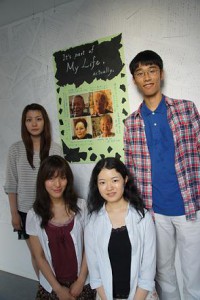“It’s part of my life , actually.”(Hijiri Tomiyama)
公開日:07/22/2011
投稿者:ut-student_2011s
Hi, I’m Hijiri Tomiyama.
As my friends explained already, we held the exibition of Hibakushas’ testimonies at the University of Tokyo.
Our group wanted to show Hibakushas’
a kind of philosophical views of their experiences through this work. So we tried to choose pictures which express their cheerful faces and phrases which quote their positive statements.
There are those who hate the war or the atomic bomb itself , and those who hate the Japan and America because of their mistakes , and many of them tell that they are distressed by a feeling of guilt about their survival.In fact,we don’t experience the atomic bomb , so we can only image their physical and mental pain and feel so sorry. Their conflicts are too complicated for us to understand completely. They are tormented by the fact that even though a lot of their family and friends died , they still survive. They say “we were lucky enough”.
However , in spite of their hard experiences , they have to get over it and continue to live in this world. One of Hibakushas’ said that “It’s part of my life , actually”. We cannot and don’t want to believe that such a cruel event was real , but for them , it was a crucial part of their life . But it seems that they are accepting their experience as reality for me. When we heard their testimonies , we feel not only their grief but also their strength from their attitude.
Thank you for your reading.
The Exhibition at the Gallary(Miki Okamoto)
公開日:07/17/2011
投稿者:ut-student_2011s
Hello, I’m Miki Okamoto.
As Yuta wrote yesterday on this blog, we exhibited testimonies of hibakushas at a gallery in our campus. Yuta has already written about the process of this exhibition and carried some pictures on this blog. So I’d like to introduce a work 0f our group.
Our group used four pictures to show visitors the incurable scar on the body of hibakushas. They are still suffered from physical pain over 66 years since August 1945. Time does’t cure thier pain. One of the hibakushas said that “I still suffer from this scar. I always feel a piercing pain as if someone poked me with knife or pencil.”
In addition, the endless mental damage of hibakushas compares to the testimony which was written in helical manner. The shape of spiral indicates that hibakushas can’t diminish their scar on their body but also they can’t escape from their awful memory of atomic bomb infinitely. They still suffer from continuous pain both physically and mentally. We wanted to tell visitors this fact and want them to think about pain of hibakushas again and more carefully.
We tend to turn away from horrible scar of this tragic incident but we want to say that everyone should look this fact with profound consideration.
I hope that this work will give everyone opportunity to think of it again.
Eternity of the Memory – an Exhibition at the Gallary
公開日:07/15/2011
投稿者:ut-student_2011s
Hi. I’m Yuta Ikeda. Last week, we exhibited testimonies of hibakushas at a gallary in our campus. I’m going to write about it.
Thanks to Shinpei Takeda, a director of the film “HIROSHIMA NAGASAKI DOWNLOAD”, we watched the videos of interview to a hibakusha, conducted by him. We made a script from the interview, writing down one word to another onto manuscript paper. We discussed how to exhibit testimonies, advised by Mr. Takeda. After some discussions, we decided to cover all the wall with lots of manuscript papers, to design the background by manuscript papers themselves, and to make six works of art expressing what we were inspired. (Please have a look at photos.)
Now I’ll introduce a work by our group, one of the six groups. As you see in the photo below, we drew a phrase “To think about the Abomb, the first thing I remember is the scene of the brother and his sister. Then I can’t say any more. I always pray for them that they rest happily in the heaven. I saw tens and hundreds of suffering people, but I especially remember the boy picking up retten noodle, not eating it himself but having his sister eat.” in a shape of an infinity sign. We tried to express that each one has something that is not forgotten but remains in one’s heart. The speaker seems to be living a completely new life, but he has such a feeling that lasts silently at the bottom of his heart. It repeats, being recalled from time to time.
What I think is important in conveying the memory is, to express “us presently facing to the memory of hibakusha”. We should input something by hibakusha’s memory, digest them, and output not directly what we input but actively adding what we interpreted, in some case.
Y.I.







